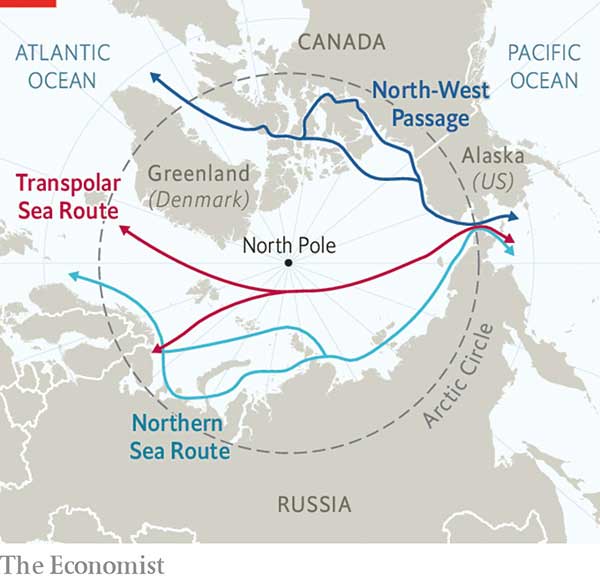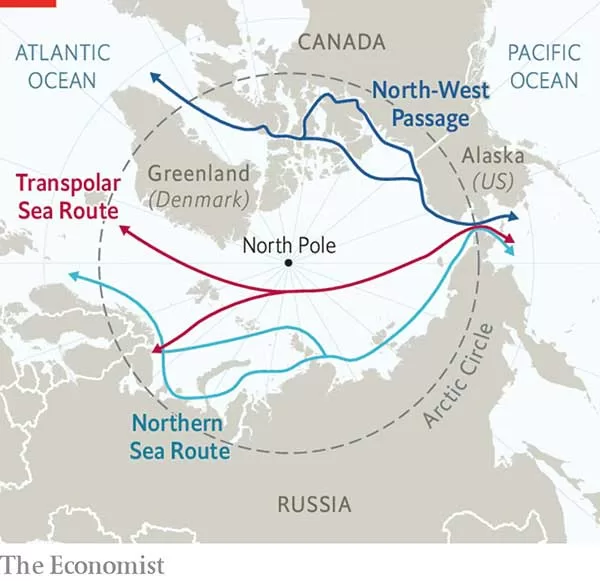The volume of trade passing through the Panama Canal, which connects the Atlantic and Pacific Oceans, has declined by 30% since November, after severe drought hit its reservoirs, lowering the water level. The spot rate for sending a 40-foot container from China to northern Europe has risen by 283% since early-December, according to figures from Freightos, an online freight marketplace.


There is a tantalising alternative for long-distance sea trade: a series of routes that could cut up to 40% off the length of journeys made via the Suez Canal. But there is a catch: the Northern Sea Route (NSR), North-West Passage (NWP) and Transpolar Sea Route (TSR) cross an ocean covered in ice. Could the Arctic be a viable option for commercial shipping?
Increasingly, yes — and for a worrying reason. The Arctic is warming four times faster than the global average. Since 1978 ice cover has shrunk by roughly 78,000 square kilometres per year. In June 2023 a study in Nature Communications, a journal, suggested that the Arctic’s first ice-free summer could come as soon as the 2040s, even if the world significantly reduces its greenhouse-gas emissions. As ice thins and cold-water shipping technology advances, Arctic waters will become more easily navigable.
They are already getting busier, if from a low base. The most popular shipping route in the Arctic is the nsr, which is controlled by Russia. Trade volumes along the route increased by 755% between 2014 and 2022. Russia wants traffic to increase ten-fold from 2022 levels by 2035. In October it announced a joint venture with DP World, an Emirati logistics company, to develop Arctic container shipping. That month NewNew Shipping Line, a Chinese firm, completed its first round-trip on an Arctic route between Shanghai and St Petersburg.
But Arctic shipping remains negligible by world standards. In 2022 fewer than 1,700 ships entered the Arctic; over 23,000 went through the Suez Canal and 14,000 through the Panama Canal. Shipping along northern routes remains seasonal: most voyages are made in the summer. The nwp has more ice than the nsr and attracts less traffic. The tsr will be navigable only by heavy icebreakers until its ice melts sufficiently. All this makes insurers wary. Poor mapping, combined with extreme and unpredictable weather, increases the likelihood of accidents. And time savings are uncertain. According to a study published in April 2023 in Geophysical Research Letters, another journal, delays due to sea fog account for 23-27% of sailing time along the nwp and 4-11% along the nsr. Arctic navigation requires expertise and specialist ships. Both come at a cost.
Mounting geopolitical tensions will also hinder trans-Arctic shipping, at least in the medium term. Ships must have permission from Russian authorities to sail along the nsr: almost no Western vessels use it. Canada and America disagree on transit rules along the nwp. Eventually, as the Arctic warms further and international waters along the TSR open up, political tussling may become less important.
Environmental concerns about shipping in the Arctic, by contrast, will only grow. In 2021 the International Maritime Organisation, a un agency, adopted a ban on heavy fuel oil in the Arctic, as it has in the Antarctic, which will come into force in 2029. This, it hopes, will reduce the risk of oil spills and harmful pollutants. Air, water and noise pollution from shipping threatens native species and the local people who rely on them. A few companies have pledged not to ship goods through the region on environmental grounds.
The Arctic will struggle to rival established shipping routes. Extreme seasonal weather limits its potential for commercial shipping. But as the ice cover shrinks, its waters will become busier — and Russia will make ever greater use of them.
